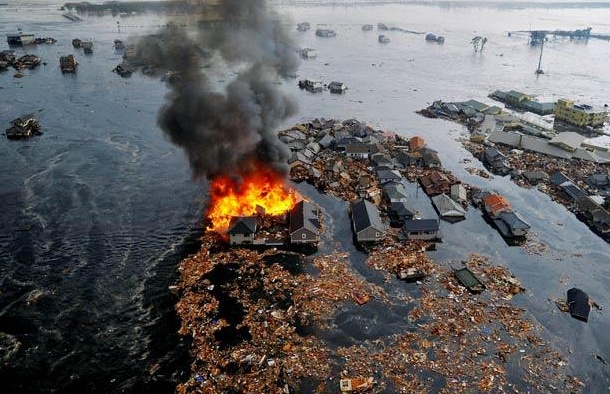Reuters photo
By
Zeeshan A. Shah
In March 2011 Japan was devastated by a deadly earthquake followed by a giant Tsunami that led to the deaths of over 6000 people. Six years after, the areas of Northern Japan bear witness to a wasteland inhabited by wild boars as human populations had vanished after the Fukushima Nuclear disaster.
Hundreds of toxic and radioactive beasts crowd the forests and streets, leading to a new threat to future human settlements as Japan plans to lift evacuation orders over a few towns in the 12 miles extension zone around Fukushima; life is far from normal.
According to recent tests conducted by the Japanese Government, the radiation levels found in the wild boar population are 300 times higher than the safety standards. Besides the widespread threat to cattle, farms and human populations by these dangerous animals, rat infested colonies and infected wild dogs are also a rising threat in the 12 miles radius zone around the Fukushima Nuclear Plant Site, comprising of 3-4 towns where the authorities are now considering a “risk free zone” for returning human populations back in the area.
A team of hunters will now extinguish this threat in order to resettle the residents to begin life back to Fukushima. Since 2014, over 13,000 boars have been killed, yet with an estimated loss of over $854,000 in agriculture losses and more animals to exterminate, it is challenging ahead for the people of Northern Japan as the Fukushima nightmare continues, people fearing for their children’s health and future state of life.
For those who remember the dangerous extent of the Fukushima environmental disaster, memory serves us well. Impacts take decades and eventually assume catastrophic proportions. For years, the issue of nuclear radiation was concealed by the media, the public remaining misinformed as war and consumerism dominated global news. We cannot quarantine the entire ocean. Past evidence shows open dumping of radioactive waste being carried out off the Japanese coast by the Fukushima Power Plant in Japan. The air around the Power Plant is full of Hazardous Radio-Nuclides such as Iodine-131, Cesium-137 and other Isotopes that are being released in the sea and air around Fukushima. Once these things enter the system inside the body, they affect body organs such as liver, thyroid, bone and brain with high doses of Alpha, Beta or Gama Radiation, leading to uncontrolled cell replication, better known as Cancer. These nuclides remain within the food chain- Algae, Crustaceans, Small Fish, Big Fish, Humans, or Soil Grass, Cow Meat and even Milk.
The Tokyo Electric Power Company (TEPCO) had been dumping the radioactive water in the Pacific Ocean, previously stored at the Fukushima Nuclear Facility. This radioactive dumping has increased radiation levels in and around the area creating an environmental nightmare. Hundreds of tons of radioactive water are being released in the ocean every single day. In August 2013, hundreds of dead fish were washed over the Coast of Karachi in Pakistan. The same year, thousands of dead fish were washed ashore in China. As far back as 2012, Cesium-137 was discovered in high percentages in the Japanese fish exports to Canada. Evidence further confirmed facts as fish caught off the Fukushima coastline were discovered to have 124 times the safe level of radioactive cesium. This is an unprecedented event witnessed for the first time, explaining the events of mysterious mass deaths in the oceans surrounding the Pacific and Southern China, all the way to the American shores. Fish is bread and butter for a lot of emerging countries like Pakistan, Hong Kong, Thailand, Japan and Singapore.
According to a study by the University of South Wales Australia, the radioactive waste has traveled all the way from Japan to the United States through the Pacific Ocean sometime this year. The world media needs to be more environmentally conscious as more cases of Dead Sea Life are seen and observed across the globe. People in poor nations do not have health care like in Canada and America, though they were always thought to have safer waters, to fish from and to earn a living. We are still not fully aware of the extent of the damage already done to the marine and ocean life and what will be its next effect. Declining to forge a more robust environmentally active form of governance, big nations like China and USA are not abiding by the Paris Accord that binds all countries against taking risks that impact human lives. A dangerous precedent must not be created as emerging nations are under a rising environmental threat.
The Fukushima disaster, after the 2011 Earthquake and Tsunami, triggered this crisis and it has now been over six years. In a local Japanese government survey last year, more than half of Fukushima’s former residents said they wouldn’t return, citing fears over radiation and the safety of the nuclear plant, which will take 40 years to stabilize the environment as human friendly. The collective drive against environmental pollution is the key challenge for this delicate country having borne the brunt of Nuclear threats, leaving the lesson for other countries to wake up to this challenge – A deadly environmental threat beyond the Pacific.



No Comments Yet!
You can be first to comment this post!